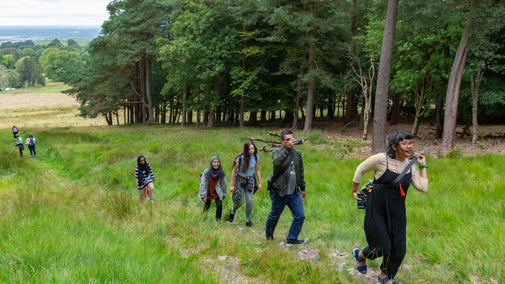Paradise on the Isle of Wight butterfly walk
Isle of Wight
This moderate walk passes along the chalk ridge that runs through the middle of the Isle of Wight. This swathe of downland is one of the best places in the country for spotting wonderful butterflies: Adonis blue and chalkhill blue species live here in abundance, with large populations of small blue, dark-green fritillary and Glanville fritillary as well. Brown argus and grayling can also be spotted, and in late summer you can often catch a glimpse of the clouded yellow.
Near to
Compton Bay and DownsStart point
Compton Chine/Afton Down car park, grid ref: SZ367854Trail information
More near here
Compton Bay and Downs walk
A 7.5 mile walk around Compton Bay and Afton Ridge, taking in far-reaching views and the dinosaur fossil beach.

Get in touch
Our partners

We’ve partnered with Cotswold Outdoor to help everyone make the most of their time outdoors in the places we care for.
You might also be interested in
Compton Bay and Downs Compton Butterflies walk GPX file
Right-click and 'Save Link As' or ‘Save Target As’ or ‘Download Linked File As’ (depending on your browser) to download this Compton Butterflies walk GPX file to your device, then open with your GPS program.
Walking
Explore some of the finest landscapes in our care on coastal paths, accessible trails, woodland walks and everything in between. Find the best places to walk near you.

Things to see and do at Compton Bay and Downs
Discover one of the Isle of Wight’s favourite spots with plenty of space to explore, search for fossils, spot local wildlife, surf, cycle and ride your horse.

Visiting Compton Bay and Downs with your dog
Discover all about visiting Compton Bay and Downs, Isle of Wight, with your four-legged friend. Compton Bay and Downs is a two pawprint rated place. Please be aware that at this time of year (until 15 Sept) dogs are are not permitted on the beach west of Compton Bay car park but are welcome on the beach between Hanover Point and Brook Chine.

Walking on the Isle of Wight
From discovering dinosaur fossils on a walk at Compton Bay and Downs to the secluded creeks and waterways of Newtown National Nature Reserve, find out where to go for the best walks on the Isle of Wight.

Staying safe at National Trust places
The special places in National Trust care sometimes come with a few risks for visitors, be it coastline or countryside. Find out how to keep safe throughout your visits.

Follow the Countryside Code
Help to look after National Trust places by observing a few simple guidelines during your visit and following the Countryside Code.

Cotswold Outdoor: our exclusive walking partner
Learn about the National Trust’s ongoing partnership with Cotswold Outdoor. Find out how they help us care for precious places and the exclusive discount available for National Trust supporters.




